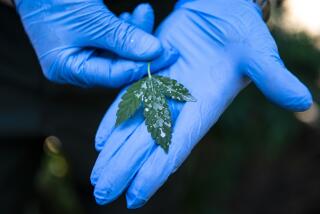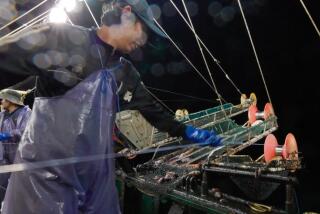NEWS ANALYSIS : Industry Almost Alone at Helm on Seafood Safety
- Share via
After years of anticipation, hearings, scientific review and contamination-related controversy, the new federal seafood inspection program is decidedly anticlimactic.
Announced by the U.S. Food and Drug Administration earlier this month, the program places the primary burden for safe and wholesome seafood products on domestic and foreign processors in the form of a record-keeping honor system.
The federal government will assume no additional responsibility for oversight of an industry that has been haphazardly regulated and whose products have been linked to serious food-borne illnesses.
The lack of a more coherent federal role came under fire almost immediately by consumer advocates. Critics had lobbied for more aggressive government inspections of the incredibly diverse seafood industry, whose products come from hundreds of sources worldwide.
Among the inspection plan’s omissions is mandatory laboratory testing for bacteria, toxins and chemical contaminants. Such tests, which can be costly, will be at the discretion of the seafood operator.
“This is a system based on blind faith,” said Caroline Smith DeWaal, food safety director for the Center for Science in the Public Interest in Washington. “It requires seafood processors to use in-plant controls to prevent contamination, but these controls aren’t [then verified] using laboratory tests.
“This program lacks accountability,” Smith DeWaal continued. “You can have the best laws in the world, but without police enforcement, they are useless.”
Philip Spiller, director of the FDA’s Office of Seafood, says laboratory testing is just one means of determining whether the product is safely produced.
Lab tests, he said, often produce mixed results by showing that one part of a shipment is positive for harmful bacteria and another part of the same shipment is clean. Nevertheless, FDA inspectors will continue to take product samples during plant inspections for laboratory analysis.
The seafood industry, with the exception of fishing boats, trucks and retail outlets, will be required to maintain detailed records of company food safety efforts under the new inspection guidelines called Hazard Analysis Critical Control Point. The plan will be phased in over two years.
The FDA places the current rate of illnesses linked to seafood at 114,000 cases a year. The figure is imprecise because there are no consistent statistics maintained on the subject by the federal, state or local health departments. Only the most severe outbreaks are recorded by health officials, leaving minor outbreaks affecting one or two people uncounted. The FDA contends that the hazard analysis program, when fully implemented, will reduce the number of illnesses by 20,000 to 60,000 a year.
Meanwhile, the FDA will not be allocated additional resources or personnel to inspect plants and review records. The FDA inspects each of the nation’s 4,800 fish and shellfish processors about once every two years, Spiller says.
However, Smith DeWaal says the extra record keeping required under the hazard analysis program will slow the rate of federal plant inspections to as infrequently as once every five years.
Under the program, fish processors will be required to keep daily records of how they are preventing contamination at critical junctions in handling, processing and storage. FDA inspectors will then review the performance records, functioning more like IRS auditors than like health officials making unannounced site inspections.
Seafood industry representatives say the move to hazard analysis is a vast improvement over the current FDA inspection program and contend that the record-keeping requirements are more meaningful than an occasional surprise inspection.
“HACCP makes wise use of limited federal dollars [and] . . . mandates preventive controls,” said Lee J. Weddig, executive vice president of the National Fisheries Institute, an Arlington, Va.-based trade group. “This directs industry attention to the specific areas of concern and also makes the best use of federal and state inspection personnel in that they will now be able to look at HACCP records dating back to the last inspection visit and get a ‘historical’ representation of activities at the seafood facility. Under the previous program, inspectors could only evaluate what they saw on the day of the visit.”
The U.S. Department of Agriculture is also in the final stages of formulating a hazard analysis plan for meat and poultry plants. However, the USDA operates a far more extensive program with a $500-million annual budget and inspectors in place at every slaughter or processing plant whenever the facility is operating. By comparison, the FDA spends only $37 million inspecting the commercial seafood industry, with annual revenue of $40 billion.
More to Read
Inside the business of entertainment
The Wide Shot brings you news, analysis and insights on everything from streaming wars to production — and what it all means for the future.
You may occasionally receive promotional content from the Los Angeles Times.










